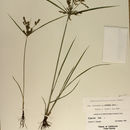Comments
provided by eFloras
台灣特有種
- license
- cc-by-nc-sa-3.0
- copyright
- Missouri Botanical Garden, 4344 Shaw Boulevard, St. Louis, MO, 63110 USA
Comments
provided by eFloras
Cyperus iria was first recorded in the New World from the southeastern United States in the 1840s.
- license
- cc-by-nc-sa-3.0
- copyright
- Missouri Botanical Garden, 4344 Shaw Boulevard, St. Louis, MO, 63110 USA
Description
provided by eFloras
台灣特有種
- license
- cc-by-nc-sa-3.0
- copyright
- Missouri Botanical Garden, 4344 Shaw Boulevard, St. Louis, MO, 63110 USA
Description
provided by eFloras
Herbs, annual, cespitose. Culms trigonous, (5–)20–60 cm × (0.2–) 0.6–2.4 mm, glabrous. Leaves (1–)3–4, V-shaped, 15–40 cm × 3–6 mm. Inflorescences: spikes 2–5(–8), oblong to ovoid, 2–10 cm × 3–12 mm; rays 4–8, to 11 cm; bracts (4–)5(–7), ascending at 45°, V-shaped, (1.5–)8–30(–50) cm × 1–6 mm; rachilla persistent, wingless (successive floral scales 0.7–0.9 mm apart). Spikelets 10–30, compressed, linear to ellipsoid, 4–20 × 1.5–2.1 mm; floral scales deciduous, (2–)6–26, laterally brown to golden brown, edges clear, medially green, 5-ribbed, outermost ribs more noticeable than others, obovate to nearly orbiculate, 1.3–1.8 × 1.2–1.8 mm, margins emarginate, apex with mucro 0.05–0.12 mm. Flowers: stamens 2(–3); anthers (0.2–)0.3–0.4 mm, connective tips reddish, less than 0.1 mm; styles less than 0.1 mm; stigmas 0.2–0.4 mm. Achenes brown, slightly stipitate, obovoid, 1.2–1.4 × 0.5–0.7 mm, apex apiculate, surfaces puncticulate.
- license
- cc-by-nc-sa-3.0
- copyright
- Missouri Botanical Garden, 4344 Shaw Boulevard, St. Louis, MO, 63110 USA
Description
provided by eFloras
Annual, 20-70 cm, solitary or forming small tussocks. Rhizome small. Stem 2-3 mm diam., trigonous, smooth. Leaves up to equalling stem; sheaths to 20 cm, soft, yellow brown, sometimes with reddish tint, finely brown-dotted, mouth margin straight; ligule 0; blades to more than 30 cm, 2-5 mm wide, flat, keeled, green or greyish green, margins slightly revolute, margins and keel towards the apex scabrous, apex acute, scabrous. Inflorescence a compound anthelodium, 5-20 cm; 4-6 bracts foliose, to more than 25 cm, much longer than inflorescence; primary branches up to 15 cm, rigid; secondary anthelodium 20-50 mm; tertiary anthelodium 20-30 mm; cluster of spikes 10-40 mm, spikate, erect, lax, with c. 40 spikes; spikes 3.5-5 x c. 2 mm, compressed, lax, with 5-20 flowers, glume-like bract c. 1 mm, glume-like prophyll scarious, bi-nerved; rachis c. 0.4 mm wide, 4-angled, flat, brown, narrowly winged, internodes c. 0.6 mm; glumes c. 1.5 mm, cymbiform, keeled, mucronate, sides nerveless, yellow-brown, shiny, margins scarious. Stamens 2; stigmas 3. Nut c. 1.2 x 0.6 mm, rather sharply trigonous, ellipsoid, brown or dark brown, finely papillose.
- license
- cc-by-nc-sa-3.0
- copyright
- Missouri Botanical Garden, 4344 Shaw Boulevard, St. Louis, MO, 63110 USA
Distribution
provided by eFloras
台灣特有種
- license
- cc-by-nc-sa-3.0
- copyright
- Missouri Botanical Garden, 4344 Shaw Boulevard, St. Louis, MO, 63110 USA
Distribution
provided by eFloras
Distribution: Weed in Old World tropics and subtropics; most common in SE Asia from India to Japan and Malaysia, west to Tadjikistan, Kazakhstan and Uzbekistan (Aral Sea region), Caucasus, Iraq; E., S. and W. Africa, Madagascar; Australia and Pacific Islands; the Americas.
- license
- cc-by-nc-sa-3.0
- copyright
- Missouri Botanical Garden, 4344 Shaw Boulevard, St. Louis, MO, 63110 USA
Distribution
provided by eFloras
Tropical, subtropical and temperate regions of both hemispheres.
- license
- cc-by-nc-sa-3.0
- copyright
- Missouri Botanical Garden, 4344 Shaw Boulevard, St. Louis, MO, 63110 USA
Distribution
provided by eFloras
introduced; Ala., Ark., Calif., Conn., Fla., Ga., Ill., La., Md., Miss., Mo., N.Y., N.C., Okla., S.C., Tenn., Tex., Va., W.Va.; Mexico; Central America; South America; Asia; Africa; Australia.
- license
- cc-by-nc-sa-3.0
- copyright
- Missouri Botanical Garden, 4344 Shaw Boulevard, St. Louis, MO, 63110 USA
Elevation Range
provided by eFloras
200-1800 m
- license
- cc-by-nc-sa-3.0
- copyright
- Missouri Botanical Garden, 4344 Shaw Boulevard, St. Louis, MO, 63110 USA
Flower/Fruit
provided by eFloras
Fl. Per.: May - October.
- license
- cc-by-nc-sa-3.0
- copyright
- Missouri Botanical Garden, 4344 Shaw Boulevard, St. Louis, MO, 63110 USA
Flowering/Fruiting
provided by eFloras
Fruiting summer–fall (Jul–Oct).
- license
- cc-by-nc-sa-3.0
- copyright
- Missouri Botanical Garden, 4344 Shaw Boulevard, St. Louis, MO, 63110 USA
Habitat
provided by eFloras
In fields, especially rice fields, borders of irrigation ditches; common according to R.R.Stewart (l.c. 1972).
- license
- cc-by-nc-sa-3.0
- copyright
- Missouri Botanical Garden, 4344 Shaw Boulevard, St. Louis, MO, 63110 USA
Habitat
provided by eFloras
Damp to moderately dry, disturbed soils; 0–500m.
- license
- cc-by-nc-sa-3.0
- copyright
- Missouri Botanical Garden, 4344 Shaw Boulevard, St. Louis, MO, 63110 USA
Synonym
provided by eFloras
Chlorocyperus iria (L.) Rikli, Jahrb. Wiss. Bot. 27: 564. 1895; Holm & al., World's worst weeds: fig. 95. 1977; K.M. Matthew, Fl. Tamilnadu Carnatic 4: pl.640. 1988.
- license
- cc-by-nc-sa-3.0
- copyright
- Missouri Botanical Garden, 4344 Shaw Boulevard, St. Louis, MO, 63110 USA
Cyperus iria
provided by wikipedia EN
Cyperus iria (also known as rice flat sedge and rice flatsedge) is a smooth, tufted sedge found worldwide. The roots are yellowish-red and fibrous.[2][3] The plant often grows in rice paddies, where it is considered to be a weed.[4]
See also
References

- license
- cc-by-sa-3.0
- copyright
- Wikipedia authors and editors
Cyperus iria: Brief Summary
provided by wikipedia EN
Cyperus iria (also known as rice flat sedge and rice flatsedge) is a smooth, tufted sedge found worldwide. The roots are yellowish-red and fibrous. The plant often grows in rice paddies, where it is considered to be a weed.
- license
- cc-by-sa-3.0
- copyright
- Wikipedia authors and editors

